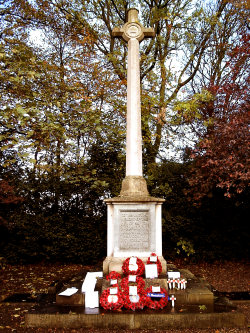SOME BRIEF
BIOGRAPHICAL DETAILS
OF JUST A FEW OF
SUTTON & WAWNE'S WAR DEAD
Lance Bombardier
Douglas Shearsmith 11051876
Our first biography is of L/Bdr Douglas
Shearsmith, who served in 242 Battery, 48
Light Anti-Aircraft Regiment of the Royal
Artillery, an ack-ack unit, and this photo
of him was taken along with his brother when
on embarkation leave in 1941, aged 19.
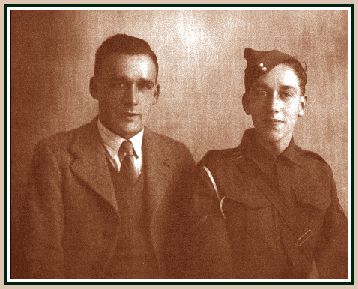
Thousands of serving men
hurried along to photographic studios when
just about to embark for foreign parts, to
have their photo taken with their families.
For those who didn't return, this was often
the last memory or momento they had of their
boy, or husband, father, etc.
And so it sadly proved to be for Douglas and
his family. His regiment originally sailed
for the Middle East, to reinforce the troops
engaged in desert warfare. Unfortunately, in
the meantime, Japan entered the conflict
after Pearl Harbor, and his convoy was
diverted a further several thousand miles to
Singapore. He and his unit arrived just in
time for the fall of Singapore, and were
surrendered without they themselves being
able to fire a shot.
Douglas then entered a period of 3 years of
unbelievable cruelty and torment. He was
imprisoned along with his friends in a
Japanese camp in Sandakan, in Borneo.
Towards the end of the war, 2000 of the
camp's inmates were force-marched hundreds
of miles as the Japanese tried to flee the
advancing allies, taking the evidence of
their inhumanity with them. Of that 2000,
only 6 survived, and Douglas was not one of
them. He died in June, 1945, aged 23, when
the war was nearly won and just two months
before hostilities against Japan came to an
end.
Douglas' body was amongst those of thousands
that were never recovered, nor any knowledge
of where his grave lies. So his name appears
on a panel on the Memorial that stands in
Kranji War Cemetery, 22 kilometres north of
Singapore.
For anyone interested in more about POW's of
the Japanese, I can recommend a book that is
still to be seen on bookstalls, in charity
shops, etc. "The Naked Island" by Russell
Braddon is one of many accounts of life as a
POW at the hands of the Japanese.
Sapper Bernard
Catterick, no 2015554, Royal Engineers,
and his wife, Doris
This following story
departs from our theme, as neither appear
on the Sutton War Memorial, but there is a
strong Sutton connection.

The above wedding photo
illustrates both the tragedy and sadness
of modern war. It was sent in by former
Sutton resident, Terry King. The groom
is his Uncle Bernard, with his bride
Doris, standing on the steps of St
James' in the spring of 1941. Three
months later, both were killed in one of
the most notorious bombing raids on
Hull. The night of 18th July, 1941 was
when Mulgrave Street shelter received a
direct hit, and most people sheltering
within were killed, most almost
instantly. It can only presumed that
Bernard and Doris died together, as did
many other complete families. It seems
they were on their way home, and caught
by the sirens, dashed down the shelter.
Tragically, Mulgrave Street was not the
only street shelter to receive a direct
hit in this way, there were others in
various raids between 1940 and 1944.
Their tragic story helps to illustrate
some of points to remember in tracing
recent family history, especially the
records of those killed in World War
Two. Bernard does not appear on the
Sutton memorial because, though he came
from a Sutton family, he was not a
Sutton resident at the time of his
death, but resident in Marfleet. The
details for his wife can be found in the
All civilians killed in the bombing in
Hull are listed there, stating their
full name, age, date of death, the place
where they died, and the grave reference
number in city records. Thus it shows:
Catterick,
Doris - 21 yrs - 18 Jul 1941 -
Mulgrave St Shelter, Hull, ERY - 2218
http://www.genuki.org.uk/big/eng/Indexes/NE_WarDead/
Bernard is not
listed, because he was not a
civilian, and presumably appears on
another memorial elsewhere, perhaps
a street memorial at some time, as
well as the Rolls of Honour compiled
and held by the Commonwealth War
Graves Commission for the Forces.
These Rolls, along with the Civilian
Rolls, are lodged in Westminster
Abbey, along with the names of the
tens of thousands of others,
military and civilian, killed in the
six years of that conflict.
Bernard was a Sapper, Royal
Engineers, so he will also be
remembered in his Regimental Rolls.
On checking the War Graves site, we
do indeed see that both husband and
wife are buried together in St
James' churchyard, and the Honour
Record details for Bernard show thus
:
Son of John and
Gertrude Catterick, of
Sutton-in-Holderness; husband of
Doris Catterick, of Hull, who was
killed in the same incident. New
Yard. Cemetery: SUTTON (OR
SUTTON-IN-HOLDERNESS) (ST. JAMES')
CHURCHYARD Yorkshire, United
Kingdom ; Grave or Reference Panel
Number: Row 7 Grave 2.
It is sobering
that the record merely describes
the tragedy as an "incident".
But we have to remember that the
Rolls only record the bare
details, a man's regiment, and
the memorial or grave on which
he appears. There were so many
killed, the action of war often
so fast, that years later when
the millions of records came to
be compiled, it was often not
known how, or indeed exactly
where, a person had died. All
that was known that someone
didn't come back .. "Missing".
So these records don't tell the
story of the action, or
incident, or sinking, that was
the cause of a death. That was
for historians to find out . .
if they can. In all too many
instances, the story of a man's
death, often in the pursuit of
saving a comrade, was later lost
when the only witnesses to an
incident were themselves killed.
In many cases, a whole unit, a
tank crew, a submarine, or a
bomber, even a battleship, were
lost all in one go. All that can
be said is, however much we
THINK we know about war, or a
battle . . it is only the tip of
the proverbial iceberg.
More information on the Hull
Blitz, including some maps of
Hull
plotting the fall of bombs, is
available on my other website at
Hull Blitz
Maps
Guardsman
David Blyth, 2657980, 1st
Bn., Coldstream Guards
killed in action, Friday, 4
August 1944, Aged 25
Son of John and Clara Blyth,
of Sutton on Hull
Husband of Mary Blyth.
David's story also appears
on the new
British Normandy Memorial
at Ver-sur-Mer, Calvados.
Guardsman
David Blyth
. . . opens in a new
window . . .
Guardsman David
Blyth is an example of a
Sutton-born man who moved away
upon his marriage, and so
doesn't appear as a Sutton man
on the CWGC list of dead of
World War Two. At the time of
his death, this soldier had
married and set up his first
home in Cleethorpes, with his
wife Mary. The CWGC site
erroneously gives his address
then as Greenford in
Middlesex, but that was
because of a misunderstanding
when the records were being
compiled long after the war.
Such errors do happen, and
these days it is far easier to
get errors ammended than
formerly simply by filling a
form downloaded online from
their website and then posting
it to the Commission HQ in
Maidenhead. David's photo here
was taken before the war, so
by the time of his death, he
was a fully trained
professional soldier that had
been in the army for some 7
years.
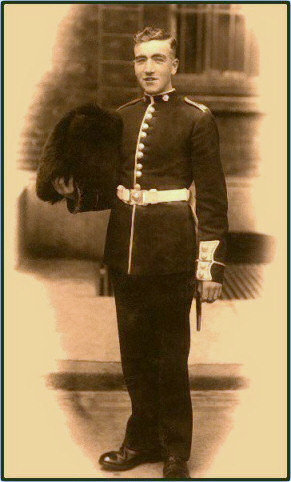 David, as with
Douglas above, is one of tens
of thousands who have no known
grave. Therefore, he is
primarily remembered on a
panel on the Bayeaux Memorial
at Calvados, in Northern
France, as well as on the
Guards' Regimental Roll of
Honour. The Bayeaux
Memorial bears the names
of more than 1,800 men of the
Commonwealth land forces who
died in the early stages of
the campaign whose bodies were
never recovered and so have no
known grave. They died during
the landings in Normandy,
during the intense fighting in
deeper Normandy itself, and
during the advance to Caen and
the River Seine to the east
and south towards Vire in
early August.
David had originally wanted to
be a policeman, and as the
requirement at that time was
for recruits to have
experienced some military
service, he joined the army.
Being well over 6ft in height,
he was able to join the
Coldstream Guards in 1937, a
good while before the war
started. He was still in the
Guards in 1939 when the Guards
Divisions were sent to France
with the B.E.F. to help the
French to oppose the feared
German attack. His infantry
unit fought mainly losing
battles all the way back to
Dunkirk, and David was one of
those many thousands fortunate
enough to be evacuated to be
re-quipped, and train to fight
another day.
But his days as an infantryman
were largely over, for the
Guards Armoured Division was
formed using elements of all
the Guards battalions. David
retrained as a tank driver,
and after some four years of
further service and much
training, his tank unit went
back into France with the
massive build up in the weeks
just after D-Day. They were
part of the huge offensive
that pushed south deep into
Normandy and those tank
killing grounds of deep lanes
and high hedges of Calvados. A
month after landing in France,
and two months after D-Day
itself, David lost his life
near the village of
Marvindiere some 25 miles SW
of Caen when his Sherman tank
was destroyed in an ambush by
a couple of lone German tanks.
His was one of those many
'smaller' actions that were so
necessary in constantly
pushing the enemy back and
ultimately driving them out of
France and back to Germany
itself. It would seem his body
was never found or officially
identified, and so could well
be one of several from his
unit buried in the war
cemetery back at Bayeaux, his
stone marked "Known unto God."
His family have never found
out exactly what happened,
such is the fog of war.
It's also a sobering thought
to remember that, though the
Allied landings had taken
place in Normandy on the 6th
of June, nearly two months
before David was killed, and
despite desperate fighting and
untold suffering, our forces
had only reached Caen and the
River Seine to the east and
those hidden villages in
deeper Calvados to the south.
Although a strong bridgehead
had been established well
inland from the beaches, which
is what David's Guards unit
were doing down to the south
at the time of his death, what
we know as the breakout, that
led to other famous actions
such as at Falaise, was still
yet to take place. In just
that two months, many of those
men saw more action, more
heroics, and more suffering
than most of us born since
will ever see in an entire
lifetime.
Two months of such hard and
heavy fighting, to gain such a
small amount of territory and
costing so many lives, is a
good indication that just
because our forces had landed
in France, the outcome was
still far from certain. D-Day
made the defeat of Hitler's
Germany possible, but it
didn't make it inevitable in
the way some films would seem
to suggest. D-Day was at the
beginning of June. David was
killed at the beginning of
August. It would be October
before the final breakout of
the huge bridgehead formed so
far that would allow
commanders to say that D-Day
had been a success and
Germany's defeat more probable
than not. Nothing was
certain until near the very
end. The Germans fought
like demented rats even when
they already knew it was lost
and there was no point to it
any longer. It would be nearly
another year, another hard
winter and many more lives
would be lost before that
final defeat came about, in
the following May.
A
Maritime Story
Captain William John
Decent
b. Myton 1861 .. d. North
Sea 1918
As befits a
maritime port city such as
Hull, here we have a
couple of photos of a Hull
and Sutton sea captain
lost during World War 1.
The photos are provided
curtesy of Jean & Dick
Guest, married at St
James' in 1943, and
Captain William John
Decent was Jean's
grandfather. His ship, the
SS Gitano, was lost with
all hands in the North
Sea, as far as we can
tell, off the coast of
Denmark. Captain Decent is
also named on the Memorial
to the Mercantile
Services, who
proportionately suffered
the most horrendous losses
at sea during the First
War too. 
This story is typical of
the thousands of merchant
ship crews who met their
fate this way, struggling
to bring essential food
supplies, as well as fuel
and rubber and all manner
of other items needed for
an island nation to
survive a major war. The
GITANO was probably taking
our export goods to
Sweden, to return with a
load of much-needed
timber. But she never got
there.
I said "during" World War
One, which isn't strictly
true. Captain Decent died
on the 23rd of December,
1918, just two days before
Christmas. But of course,
the war actually 'ended'
as we all know, on the
11th of the 11th, just
over a month before. On
the internet, at The Ships
List, they show this
Wilson Line vessel, SS
GITANO, as "went missing
at sea - probably mined".
All of which makes the
point that many deaths
occurred long after the
hostilities officially
ended. Then, as now, naval
mines still exploded and
took innocent sailors and
passengers to their
deaths, in some cases,
several years after a
conflict. Many a fishing
boat and crew have been
lost in this way, hauling
a deadly mine up hidden
amongst the fish catch in
their nets, to explode as
the catch was released
onto the deck. A ship thus
caught would sink in
seconds, lost with all
hands, without trace.
There wouldn't even be
chance to send a signal,
let alone launch a boat.
Many will see memorials to
the First World War as
having the dates,
1914-1919 .. and this is
why. Hundreds more
soldiers and combatants
from all the services died
of their wounds, or
exploding mines, or abroad
in circumstances 'caused
by the war if not during
it' for a long time
after. And so this captain
and his crew are as much a
part of our War Dead as
any others. So many deaths
appear in 1919, and
likewise later in the
Second World War, history
repeats itself yet again
with many memorials
recording Second War
deaths as late as 1947. A
frequent example of "later
tragedy" is that not all
the 'survivors' of the
Japanese POW camps, having
got home, lasted more than
another year or two.
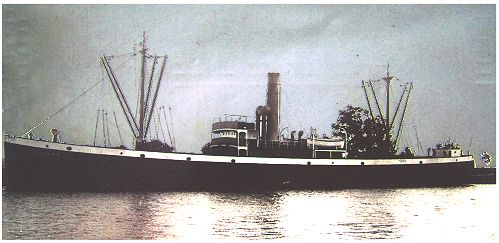
SS GITANO .. Wilson Line
.. built 1913 .. lost
1918
So here we have Captain
Decent, and his ship, lost
just before Christmas, the
first Christmas of the
Peace after 4 years of
devastating and costly
war. The sepia photo here
looks as if it could have
been taken in a North Sea
fog. A current Danish
website dedicated to
deep-sea divers tells us
that the GITANO was lost,
"on passage from London to
Gothenborg", which
suggests that she, and her
captain and crew, are
lying not far from the
Danish coast, a marked war
grave. The shame of it is,
is that in all
probability, it was one of
our own mines that she
struck.
Captain Decent was born in
1861, to parents Samual
and Hephzibah, down Cogan
Street in Myton parish. He
married Jane Nesbitt Mudd
and they had two children,
Lily, and Stanley. Captain
Decent is also
commemorated on the
Commonwealth War Graves
site below.
Second
Lieutenant Sidney
Hannaford Hellyer
4th Bn East Yorkshire
Regiment
Sydney,
pictured here at
Lambwath Hall with his
mother, Jane Elizabeth
Hellyer (1858 - 1943),
was the son of Charles
Hellyer of the
well-known Hull
shipping family.
Sydney was in the 4th
Battalion, East
Yorkshire Regiment.
His battalion took
part in the 2nd Battle
of Ypres, and Sidney
was mortally wounded
on the 8th of May,
1915. 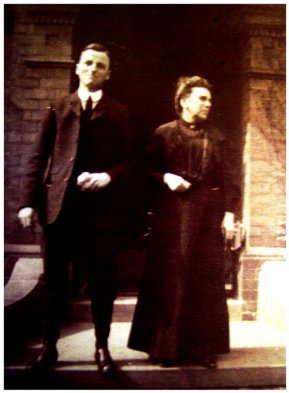
He was repatriated to
a hospital at
Boulogne, probably
with a view to getting
just well enough to be
able to board ship for
England and further
hospitalisation. But
he died of his wounds
before he could leave
France, aged just 25.
He
was one of tens of
thousands to "die of
his wounds" in the
Great War, almost
certainly of some
sort of infection,
or complications
caused by an
infection. The most
notable was
gangrene. This was
just over a decade
before the discovery
of penicillin, the
first really
effective
anti-biotic, and the
saviour of so many
more lives in the
Second War.

Though born in
Sutton, his parents
had moved back to
their own roots in
Brixham, and
somehow, that's
where his body was
finally buried. So
this son of Sutton
lies in St Mary's
churchyard, South
Devon, shown in the
photos here of both
the memorial window
his mother gifted to
the church, and his
headstone in the
churchyard. Sydney's
memorial window is
particularly
interesting as it
not only shows him
as a soldier, but is
very recognisably an
image of Sydney
himself.
Both of
these excellent
photos here are
supplied by
Peter Haywood of
the Seamens'
Christian Friend
Society in
Brixham, South
Devon, with our
thanks.
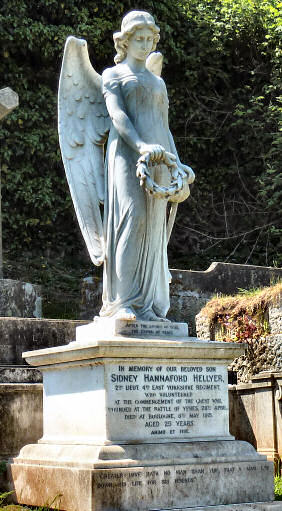
This particular
story of Lt
Hellyer and his
memorials serves
very well to
illustrate how a
man can be
remembered in
several places for
various reasons.
His family roots
were not Sutton,
but he was born
and lived here and
so is remembered
here. And as well
as in his father's
home town of
Brixham, Sydney
will also be
remembered on on
Roll of Honour in
the annals of the
East Yorkshire
Regiment. And of
course, as with
over 2 million
others, his
details and memory
are also recorded
on the
Commonwealth War
Graves site, on
the link further
below. There are
often more ways
than one of
finding a person's
details after
military service,
particularly if
they were killed
in doing that
service.
It's also worth
noting that,
though many actual
service records
for serving men
and women in the
First War were
lost in the
bombing of London
in the Second,
someone cleverly
realised that
almost every
soldier, sailor
and airmen who
served 'overseas'
was awarded a
campaign medal.
And those 'Medal
Rolls' have
survived, and in
the past year or
so, every record
has been processed
and placed on the
internet, for us
to check for free.
As of 2004, the
medal records for
all letters of the
alphabet down to
'Z' have been
available, with
only a very few
ommissions, for
over 5.5 million
men and women.
That is some
database.
|
